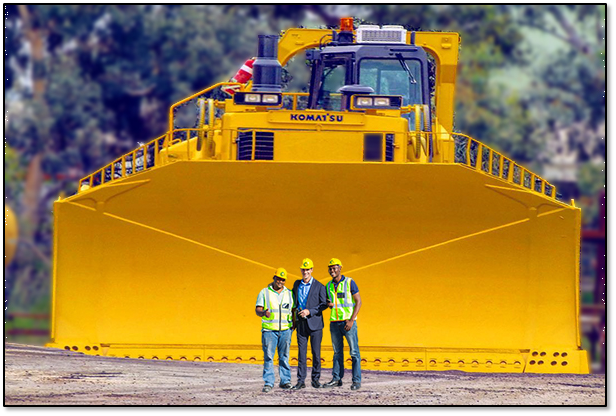
The average cubic yard of dirt will weigh between 900-1250kg. When equipped with the optional blade, this increases to 125 cubic yards. The D575A-3SD is fitted with a 3.6m high and 7.4m wide blade that can push 90 cubic yards of material with each pass. This equates to about 1500 kg of dirt moved every hour for a competent digger. At this pace it is recommended that the digger takes 15 minutes of break for each 15 minutes of work. The most efficient scoop rate for a human shovelling is 15-scoops-per-minute, with the total weight of each scoop being about 5-7kg. Image Credit: If perusing the D575A-3SD dozer photos makes you feel small, then consider the following. Komatsu, the Japanese company that has long been heralded for its innovation within machinery, have produced not only the largest production bulldozer, but also the third largest machine, making them a specialist within the superdozer business. The Komatsu D575A-3SD is unchallenged as the world’s largest production bulldozer.
#575 komatsu dozer vs d11 series#
A more accurate one however, involves a former president of Libya, a series of United Nations sanctions and a merciful Italian gardening company. A simple answer rests in Komatsu’s D575A-3SD.

“The machine is particularly well suited to ripping applications, and has proved a vital tool where blasting is not permitted for various reasons, and where ripping is the only alternative.” David Laidlaw, Komatsu Australia’s mining product manager for bulldozers and excavators, at So What Is The World’s Largest Bulldozer?īy taking a look at the dozer data available on the web, there are two answers to this question. In mines where blasting is not allowed, the dozers will be fitted with long claws at the back of their chassis that will tear through rock surfaces, creating rubble that can be easily cleared and transported. The utility that makes the dozers perfect for mining quarries however, is their ripping ability. Mammoth Tasks for Mammoth Machinesīig bulldozers are perfect for shifting huge amounts of rock, dirt and soil in open or even relatively confined areas. It has a gross power output of 936hp and exceeds 100tonnes in operating weight, which poses the question, what type of work requires these colossal specs? Building tombs for giants? Tearing through pyramids? Burying to the centre of the earth?Īustralian miners will know the answer. While the D11 takes influence from its ancestor’s design, the machine is a titan compared to any other Cat dozer. Fast forward to present day and Caterpillar are now producing the D11, the second largest production bulldozer and the biggest Cat dozer on the market. Primarily, this early model would move earth for roadwork and logging and remained a popular model until the 1930-1940’s. Their Sixty model was able to nut out sixty horsepower while weighing in at less than ten tonnes. This meant their application was incredibly versatile across construction and agriculture industries.Ĭaterpillar were developing bulldozers as early as the 1920’s. These tractors were able to traverse soft and unstable ground while remaining capable of moving large loads. Similar to the armoured tanks deployed in The Great War, bulldozers were developed from early farm tractors that had utilized the Caterpillar track. The power of the machine is not crafted for speed but thrust, meaning these bulldozers will not be weighed down by their sheer enormity. They’re precise machines, with the best of them surpassing 1000hp and weighing more than 100 tonnes. Superdozers, as these monster bulldozers are collectively known, aren’t just culminations of mass steel and circuitry. On Australian farms, some actually were tanks.

And as the great bulldozer battle waged on, dozers on the front lines began to more closely resemble tanks than construction machines. Companies were pouring assets into production lines to see who could create the biggest bulldozer without exceeding the means of practicality. The biggest bulldozer was once a trophy worth fighting for within the machinery industry.


 0 kommentar(er)
0 kommentar(er)
